Edexcel BTEC HND Business Plan: Shwe Kaung Hot Pot Restaurant Analysis
VerifiedAdded on 2023/01/30
|22
|5505
|68
Report
AI Summary
This report presents a comprehensive business plan for Shwe Kaung, a well-established hot pot restaurant in Yangon, Myanmar. It begins with an executive summary and table of contents, followed by an introduction outlining the report's purpose and scope, focusing on the Yangon market in 2021. The report delves into management and leadership fundamentals, defining key concepts like efficiency, effectiveness, and the POLC framework (Planning, Organizing, Leading, and Controlling). It explores different management types and essential managerial skills, including technical, human, and conceptual skills, along with various managerial roles. The business plan section analyzes Shwe Kaung's profile, vision, mission, and objectives. It applies PESTLE and SWOT analyses to evaluate the external and internal environments, respectively. The report further examines the organizational structure, suitable leadership styles, and controlling methods for Shwe Kaung. It also covers marketing strategies, including STP (Segmentation, Targeting, Positioning) and the marketing mix (7Ps). The report concludes with recommendations for improvement and provides a complete list of references.
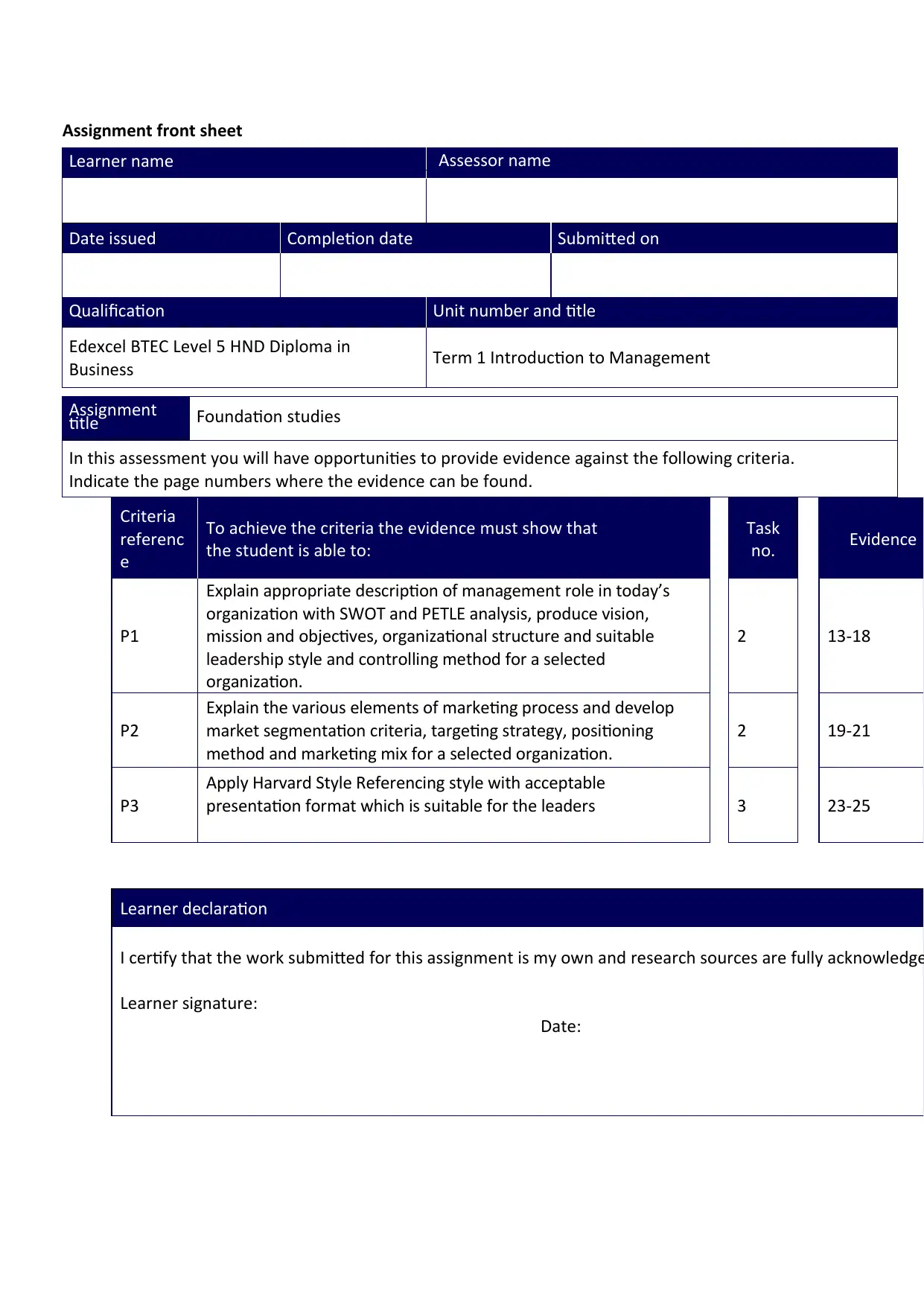
Assignment front sheet
Learner name Assessor name
Date issued Completion date Submitted on
Qualification Unit number and title
Edexcel BTEC Level 5 HND Diploma in
Business Term 1 Introduction to Management
Assignment
title Foundation studies
In this assessment you will have opportunities to provide evidence against the following criteria.
Indicate the page numbers where the evidence can be found.
Criteria
referenc
e
To achieve the criteria the evidence must show that
the student is able to:
Task
no. Evidence
P1
Explain appropriate description of management role in today’s
organization with SWOT and PETLE analysis, produce vision,
mission and objectives, organizational structure and suitable
leadership style and controlling method for a selected
organization.
2 13-18
P2
Explain the various elements of marketing process and develop
market segmentation criteria, targeting strategy, positioning
method and marketing mix for a selected organization.
2 19-21
P3
Apply Harvard Style Referencing style with acceptable
presentation format which is suitable for the leaders 3 23-25
Learner declaration
I certify that the work submitted for this assignment is my own and research sources are fully acknowledge
Learner signature:
Date:
Learner name Assessor name
Date issued Completion date Submitted on
Qualification Unit number and title
Edexcel BTEC Level 5 HND Diploma in
Business Term 1 Introduction to Management
Assignment
title Foundation studies
In this assessment you will have opportunities to provide evidence against the following criteria.
Indicate the page numbers where the evidence can be found.
Criteria
referenc
e
To achieve the criteria the evidence must show that
the student is able to:
Task
no. Evidence
P1
Explain appropriate description of management role in today’s
organization with SWOT and PETLE analysis, produce vision,
mission and objectives, organizational structure and suitable
leadership style and controlling method for a selected
organization.
2 13-18
P2
Explain the various elements of marketing process and develop
market segmentation criteria, targeting strategy, positioning
method and marketing mix for a selected organization.
2 19-21
P3
Apply Harvard Style Referencing style with acceptable
presentation format which is suitable for the leaders 3 23-25
Learner declaration
I certify that the work submitted for this assignment is my own and research sources are fully acknowledge
Learner signature:
Date:
Paraphrase This Document
Need a fresh take? Get an instant paraphrase of this document with our AI Paraphraser
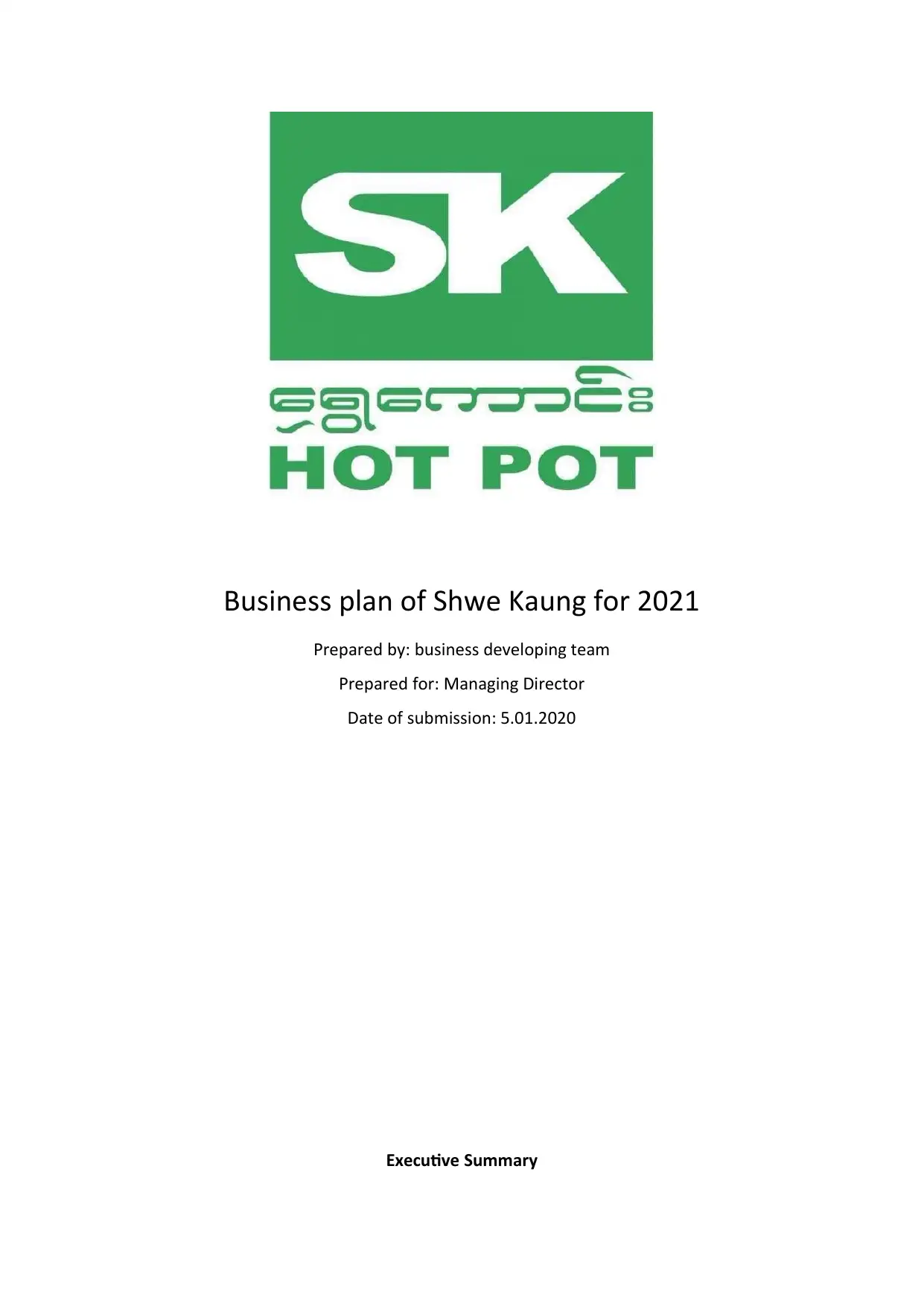
Business plan of Shwe Kaung for 2021
Prepared by: business developing team
Prepared for: Managing Director
Date of submission: 5.01.2020
Executive Summary
Prepared by: business developing team
Prepared for: Managing Director
Date of submission: 5.01.2020
Executive Summary
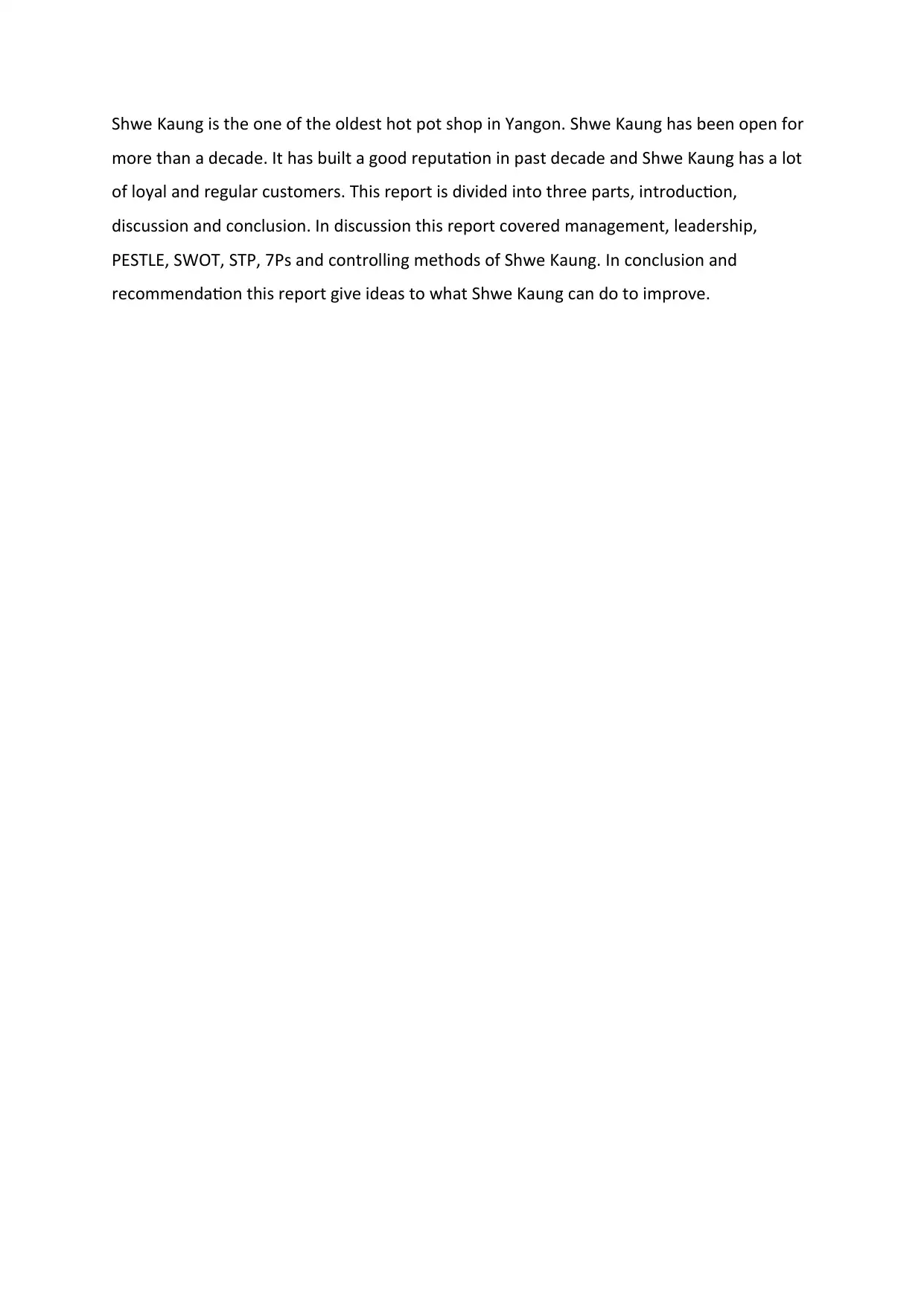
Shwe Kaung is the one of the oldest hot pot shop in Yangon. Shwe Kaung has been open for
more than a decade. It has built a good reputation in past decade and Shwe Kaung has a lot
of loyal and regular customers. This report is divided into three parts, introduction,
discussion and conclusion. In discussion this report covered management, leadership,
PESTLE, SWOT, STP, 7Ps and controlling methods of Shwe Kaung. In conclusion and
recommendation this report give ideas to what Shwe Kaung can do to improve.
more than a decade. It has built a good reputation in past decade and Shwe Kaung has a lot
of loyal and regular customers. This report is divided into three parts, introduction,
discussion and conclusion. In discussion this report covered management, leadership,
PESTLE, SWOT, STP, 7Ps and controlling methods of Shwe Kaung. In conclusion and
recommendation this report give ideas to what Shwe Kaung can do to improve.
⊘ This is a preview!⊘
Do you want full access?
Subscribe today to unlock all pages.

Trusted by 1+ million students worldwide
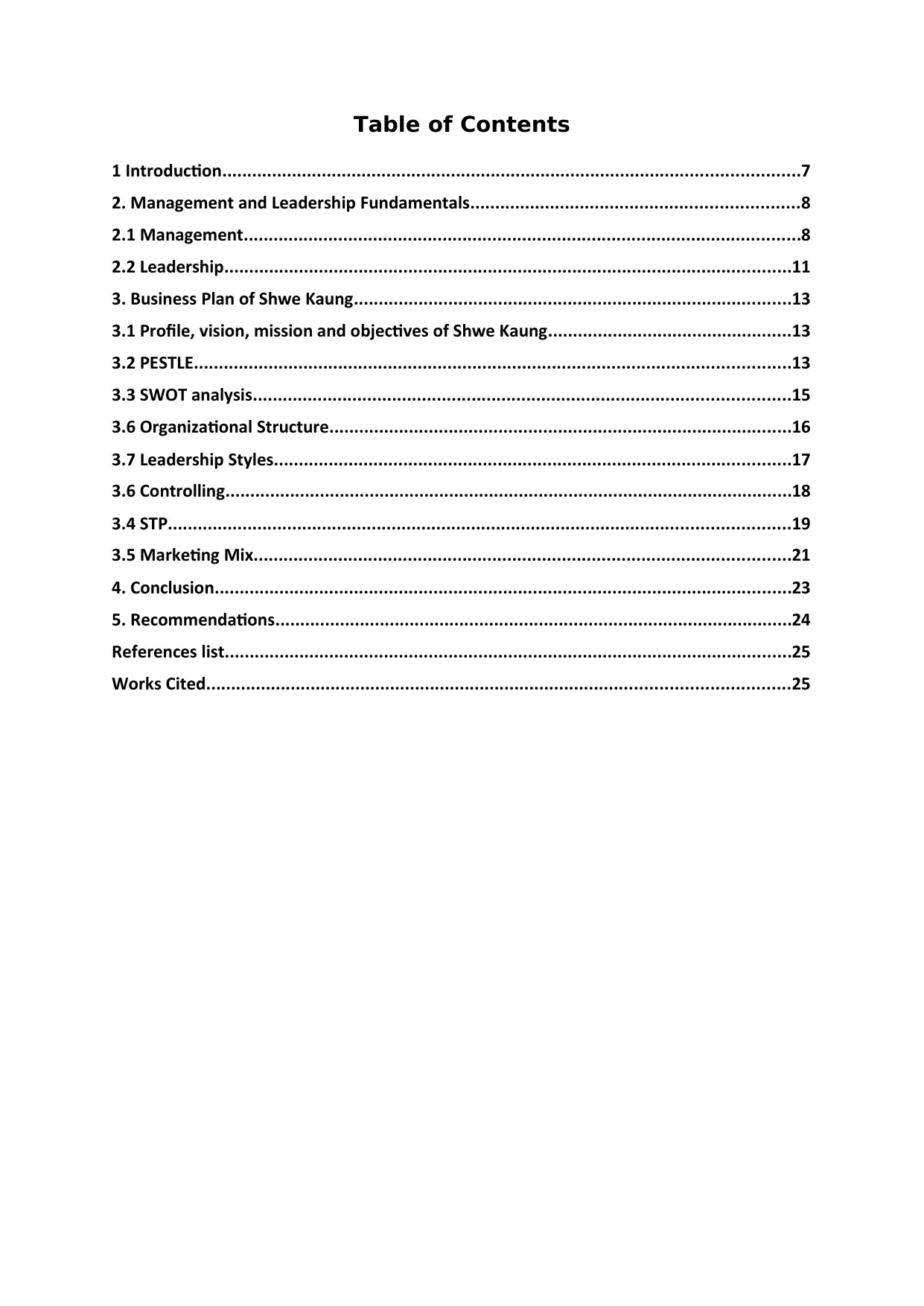
Table of Contents
1 Introduction....................................................................................................................7
2. Management and Leadership Fundamentals..................................................................8
2.1 Management................................................................................................................8
2.2 Leadership..................................................................................................................11
3. Business Plan of Shwe Kaung........................................................................................13
3.1 Profile, vision, mission and objectives of Shwe Kaung.................................................13
3.2 PESTLE........................................................................................................................13
3.3 SWOT analysis............................................................................................................15
3.6 Organizational Structure.............................................................................................16
3.7 Leadership Styles........................................................................................................17
3.6 Controlling..................................................................................................................18
3.4 STP.............................................................................................................................19
3.5 Marketing Mix............................................................................................................21
4. Conclusion....................................................................................................................23
5. Recommendations........................................................................................................24
References list..................................................................................................................25
Works Cited.....................................................................................................................25
1 Introduction....................................................................................................................7
2. Management and Leadership Fundamentals..................................................................8
2.1 Management................................................................................................................8
2.2 Leadership..................................................................................................................11
3. Business Plan of Shwe Kaung........................................................................................13
3.1 Profile, vision, mission and objectives of Shwe Kaung.................................................13
3.2 PESTLE........................................................................................................................13
3.3 SWOT analysis............................................................................................................15
3.6 Organizational Structure.............................................................................................16
3.7 Leadership Styles........................................................................................................17
3.6 Controlling..................................................................................................................18
3.4 STP.............................................................................................................................19
3.5 Marketing Mix............................................................................................................21
4. Conclusion....................................................................................................................23
5. Recommendations........................................................................................................24
References list..................................................................................................................25
Works Cited.....................................................................................................................25
Paraphrase This Document
Need a fresh take? Get an instant paraphrase of this document with our AI Paraphraser
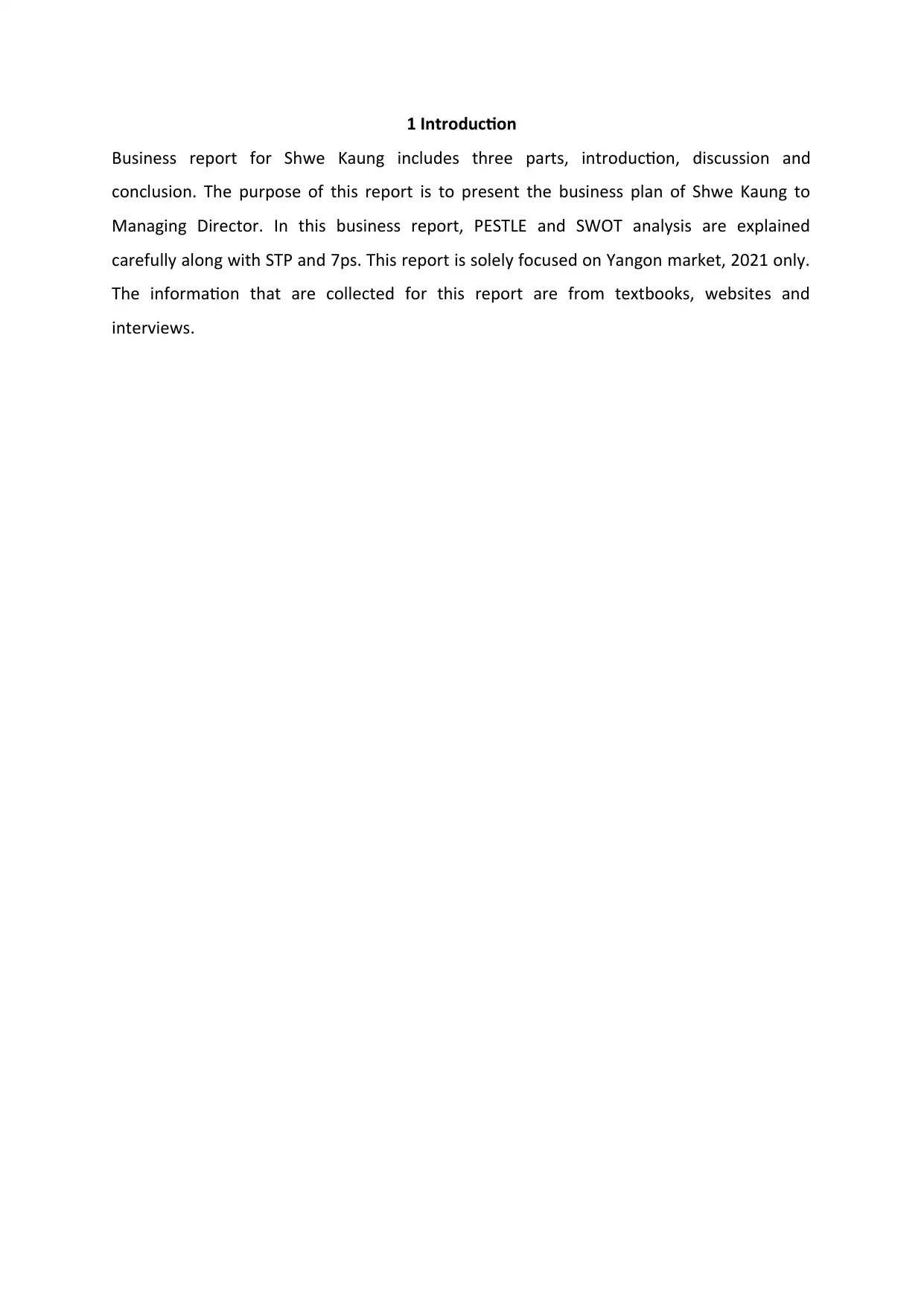
1 Introduction
Business report for Shwe Kaung includes three parts, introduction, discussion and
conclusion. The purpose of this report is to present the business plan of Shwe Kaung to
Managing Director. In this business report, PESTLE and SWOT analysis are explained
carefully along with STP and 7ps. This report is solely focused on Yangon market, 2021 only.
The information that are collected for this report are from textbooks, websites and
interviews.
Business report for Shwe Kaung includes three parts, introduction, discussion and
conclusion. The purpose of this report is to present the business plan of Shwe Kaung to
Managing Director. In this business report, PESTLE and SWOT analysis are explained
carefully along with STP and 7ps. This report is solely focused on Yangon market, 2021 only.
The information that are collected for this report are from textbooks, websites and
interviews.
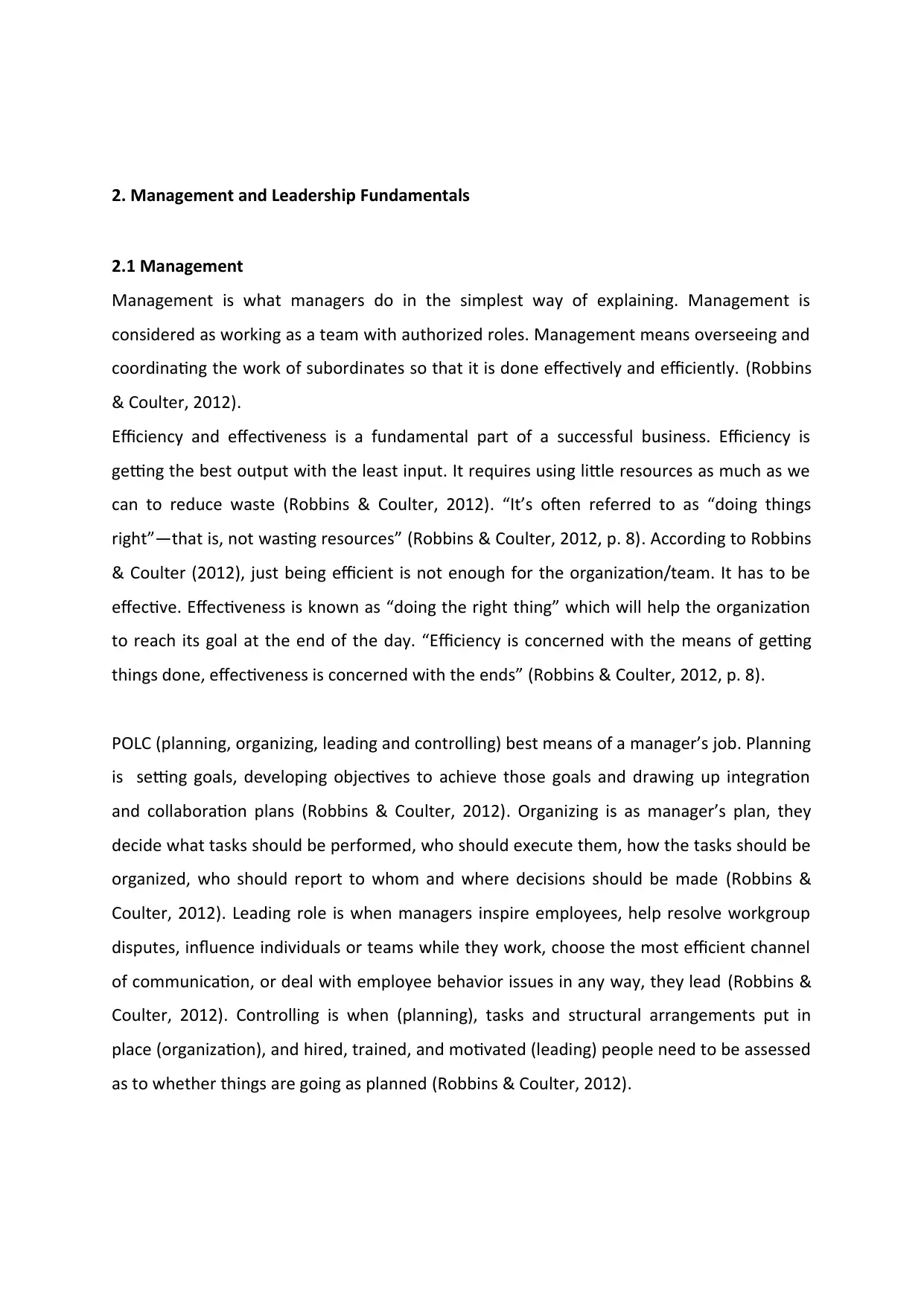
2. Management and Leadership Fundamentals
2.1 Management
Management is what managers do in the simplest way of explaining. Management is
considered as working as a team with authorized roles. Management means overseeing and
coordinating the work of subordinates so that it is done effectively and efficiently. (Robbins
& Coulter, 2012).
Efficiency and effectiveness is a fundamental part of a successful business. Efficiency is
getting the best output with the least input. It requires using little resources as much as we
can to reduce waste (Robbins & Coulter, 2012). “It’s often referred to as “doing things
right”—that is, not wasting resources” (Robbins & Coulter, 2012, p. 8). According to Robbins
& Coulter (2012), just being efficient is not enough for the organization/team. It has to be
effective. Effectiveness is known as “doing the right thing” which will help the organization
to reach its goal at the end of the day. “Efficiency is concerned with the means of getting
things done, effectiveness is concerned with the ends” (Robbins & Coulter, 2012, p. 8).
POLC (planning, organizing, leading and controlling) best means of a manager’s job. Planning
is setting goals, developing objectives to achieve those goals and drawing up integration
and collaboration plans (Robbins & Coulter, 2012). Organizing is as manager’s plan, they
decide what tasks should be performed, who should execute them, how the tasks should be
organized, who should report to whom and where decisions should be made (Robbins &
Coulter, 2012). Leading role is when managers inspire employees, help resolve workgroup
disputes, influence individuals or teams while they work, choose the most efficient channel
of communication, or deal with employee behavior issues in any way, they lead (Robbins &
Coulter, 2012). Controlling is when (planning), tasks and structural arrangements put in
place (organization), and hired, trained, and motivated (leading) people need to be assessed
as to whether things are going as planned (Robbins & Coulter, 2012).
2.1 Management
Management is what managers do in the simplest way of explaining. Management is
considered as working as a team with authorized roles. Management means overseeing and
coordinating the work of subordinates so that it is done effectively and efficiently. (Robbins
& Coulter, 2012).
Efficiency and effectiveness is a fundamental part of a successful business. Efficiency is
getting the best output with the least input. It requires using little resources as much as we
can to reduce waste (Robbins & Coulter, 2012). “It’s often referred to as “doing things
right”—that is, not wasting resources” (Robbins & Coulter, 2012, p. 8). According to Robbins
& Coulter (2012), just being efficient is not enough for the organization/team. It has to be
effective. Effectiveness is known as “doing the right thing” which will help the organization
to reach its goal at the end of the day. “Efficiency is concerned with the means of getting
things done, effectiveness is concerned with the ends” (Robbins & Coulter, 2012, p. 8).
POLC (planning, organizing, leading and controlling) best means of a manager’s job. Planning
is setting goals, developing objectives to achieve those goals and drawing up integration
and collaboration plans (Robbins & Coulter, 2012). Organizing is as manager’s plan, they
decide what tasks should be performed, who should execute them, how the tasks should be
organized, who should report to whom and where decisions should be made (Robbins &
Coulter, 2012). Leading role is when managers inspire employees, help resolve workgroup
disputes, influence individuals or teams while they work, choose the most efficient channel
of communication, or deal with employee behavior issues in any way, they lead (Robbins &
Coulter, 2012). Controlling is when (planning), tasks and structural arrangements put in
place (organization), and hired, trained, and motivated (leading) people need to be assessed
as to whether things are going as planned (Robbins & Coulter, 2012).
⊘ This is a preview!⊘
Do you want full access?
Subscribe today to unlock all pages.

Trusted by 1+ million students worldwide
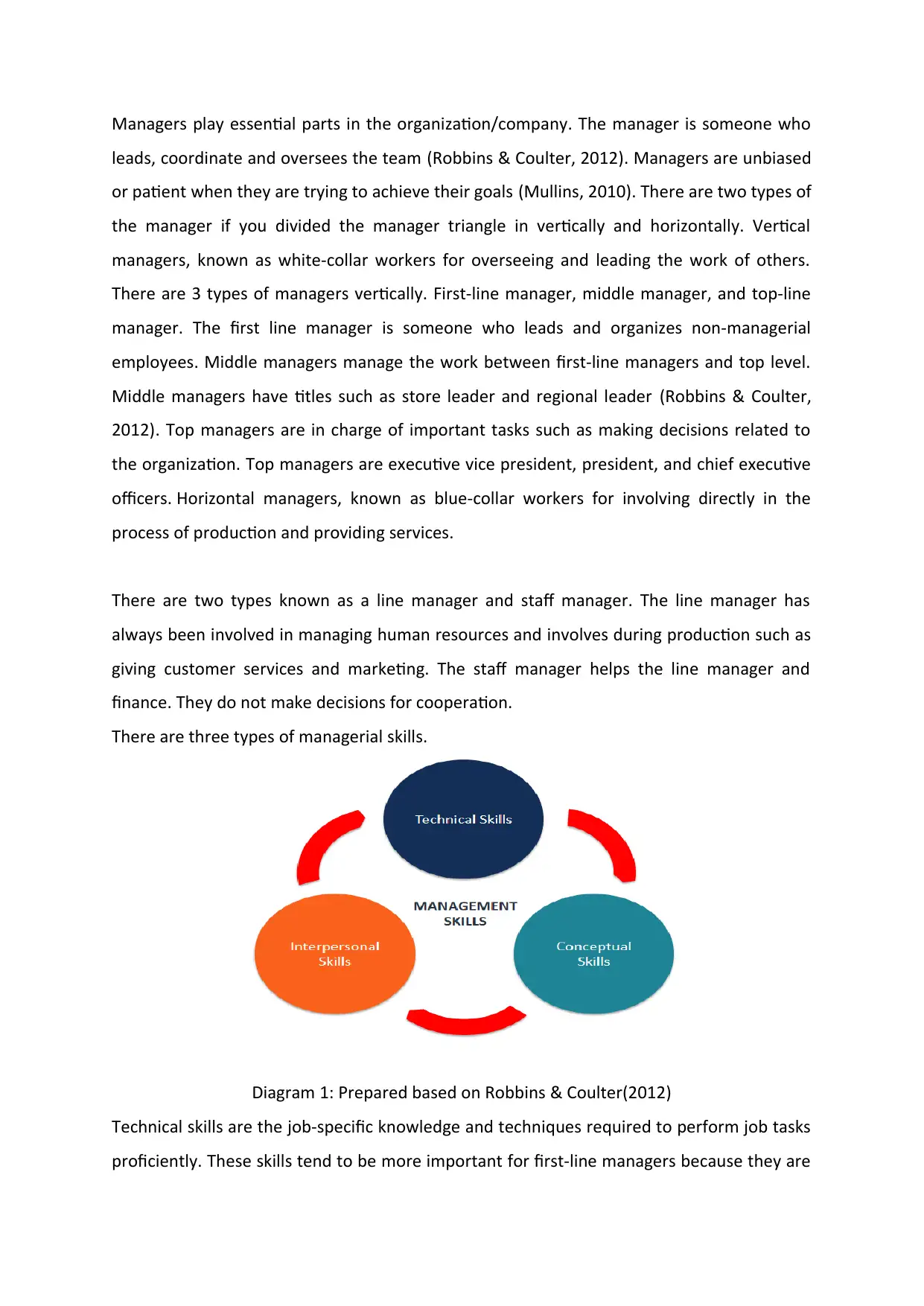
Managers play essential parts in the organization/company. The manager is someone who
leads, coordinate and oversees the team (Robbins & Coulter, 2012). Managers are unbiased
or patient when they are trying to achieve their goals (Mullins, 2010). There are two types of
the manager if you divided the manager triangle in vertically and horizontally. Vertical
managers, known as white-collar workers for overseeing and leading the work of others.
There are 3 types of managers vertically. First-line manager, middle manager, and top-line
manager. The first line manager is someone who leads and organizes non-managerial
employees. Middle managers manage the work between first-line managers and top level.
Middle managers have titles such as store leader and regional leader (Robbins & Coulter,
2012). Top managers are in charge of important tasks such as making decisions related to
the organization. Top managers are executive vice president, president, and chief executive
officers. Horizontal managers, known as blue-collar workers for involving directly in the
process of production and providing services.
There are two types known as a line manager and staff manager. The line manager has
always been involved in managing human resources and involves during production such as
giving customer services and marketing. The staff manager helps the line manager and
finance. They do not make decisions for cooperation.
There are three types of managerial skills.
Diagram 1: Prepared based on Robbins & Coulter(2012)
Technical skills are the job-specific knowledge and techniques required to perform job tasks
proficiently. These skills tend to be more important for first-line managers because they are
leads, coordinate and oversees the team (Robbins & Coulter, 2012). Managers are unbiased
or patient when they are trying to achieve their goals (Mullins, 2010). There are two types of
the manager if you divided the manager triangle in vertically and horizontally. Vertical
managers, known as white-collar workers for overseeing and leading the work of others.
There are 3 types of managers vertically. First-line manager, middle manager, and top-line
manager. The first line manager is someone who leads and organizes non-managerial
employees. Middle managers manage the work between first-line managers and top level.
Middle managers have titles such as store leader and regional leader (Robbins & Coulter,
2012). Top managers are in charge of important tasks such as making decisions related to
the organization. Top managers are executive vice president, president, and chief executive
officers. Horizontal managers, known as blue-collar workers for involving directly in the
process of production and providing services.
There are two types known as a line manager and staff manager. The line manager has
always been involved in managing human resources and involves during production such as
giving customer services and marketing. The staff manager helps the line manager and
finance. They do not make decisions for cooperation.
There are three types of managerial skills.
Diagram 1: Prepared based on Robbins & Coulter(2012)
Technical skills are the job-specific knowledge and techniques required to perform job tasks
proficiently. These skills tend to be more important for first-line managers because they are
Paraphrase This Document
Need a fresh take? Get an instant paraphrase of this document with our AI Paraphraser
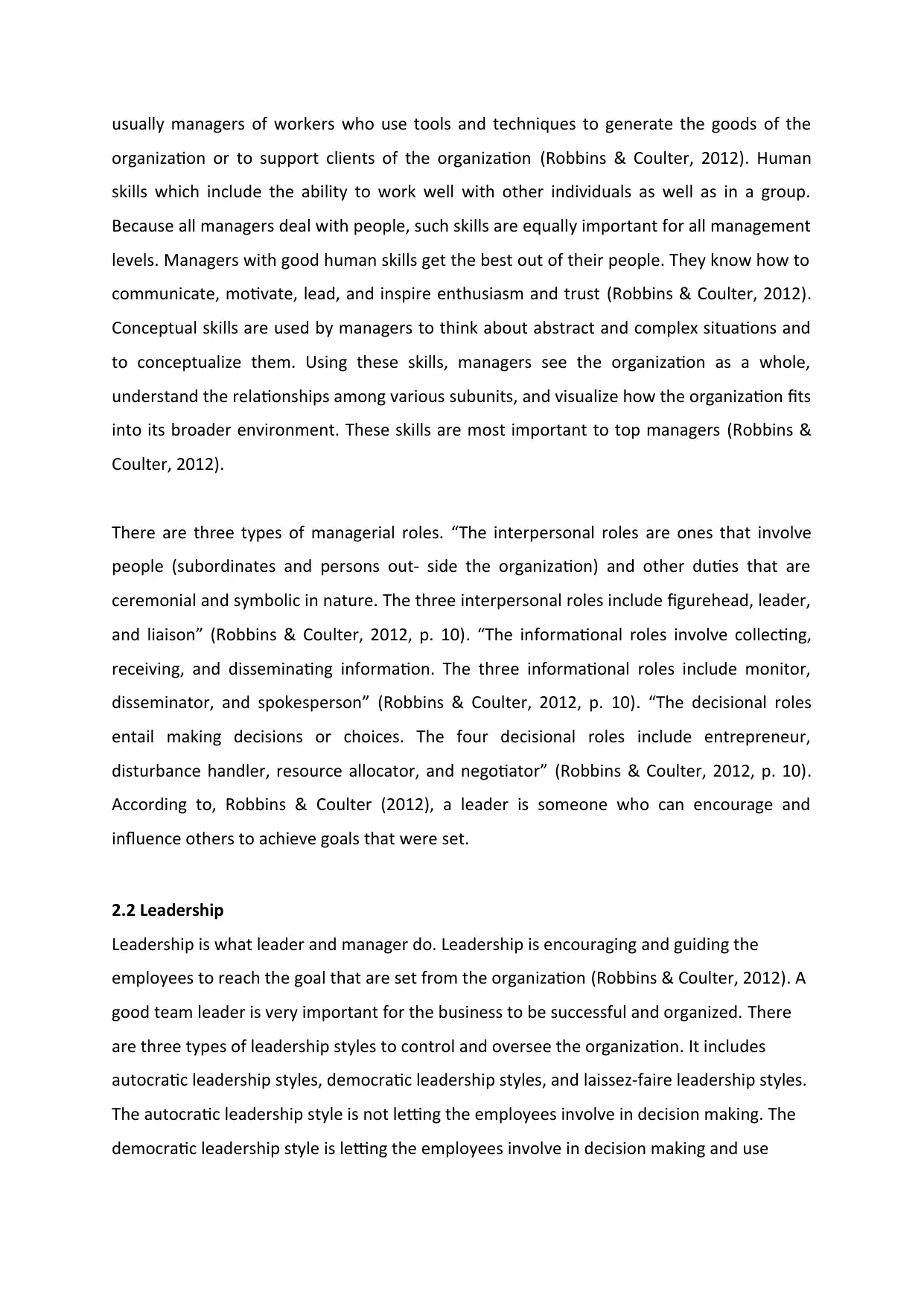
usually managers of workers who use tools and techniques to generate the goods of the
organization or to support clients of the organization (Robbins & Coulter, 2012). Human
skills which include the ability to work well with other individuals as well as in a group.
Because all managers deal with people, such skills are equally important for all management
levels. Managers with good human skills get the best out of their people. They know how to
communicate, motivate, lead, and inspire enthusiasm and trust (Robbins & Coulter, 2012).
Conceptual skills are used by managers to think about abstract and complex situations and
to conceptualize them. Using these skills, managers see the organization as a whole,
understand the relationships among various subunits, and visualize how the organization fits
into its broader environment. These skills are most important to top managers (Robbins &
Coulter, 2012).
There are three types of managerial roles. “The interpersonal roles are ones that involve
people (subordinates and persons out- side the organization) and other duties that are
ceremonial and symbolic in nature. The three interpersonal roles include figurehead, leader,
and liaison” (Robbins & Coulter, 2012, p. 10). “The informational roles involve collecting,
receiving, and disseminating information. The three informational roles include monitor,
disseminator, and spokesperson” (Robbins & Coulter, 2012, p. 10). “The decisional roles
entail making decisions or choices. The four decisional roles include entrepreneur,
disturbance handler, resource allocator, and negotiator” (Robbins & Coulter, 2012, p. 10).
According to, Robbins & Coulter (2012), a leader is someone who can encourage and
influence others to achieve goals that were set.
2.2 Leadership
Leadership is what leader and manager do. Leadership is encouraging and guiding the
employees to reach the goal that are set from the organization (Robbins & Coulter, 2012). A
good team leader is very important for the business to be successful and organized. There
are three types of leadership styles to control and oversee the organization. It includes
autocratic leadership styles, democratic leadership styles, and laissez-faire leadership styles.
The autocratic leadership style is not letting the employees involve in decision making. The
democratic leadership style is letting the employees involve in decision making and use
organization or to support clients of the organization (Robbins & Coulter, 2012). Human
skills which include the ability to work well with other individuals as well as in a group.
Because all managers deal with people, such skills are equally important for all management
levels. Managers with good human skills get the best out of their people. They know how to
communicate, motivate, lead, and inspire enthusiasm and trust (Robbins & Coulter, 2012).
Conceptual skills are used by managers to think about abstract and complex situations and
to conceptualize them. Using these skills, managers see the organization as a whole,
understand the relationships among various subunits, and visualize how the organization fits
into its broader environment. These skills are most important to top managers (Robbins &
Coulter, 2012).
There are three types of managerial roles. “The interpersonal roles are ones that involve
people (subordinates and persons out- side the organization) and other duties that are
ceremonial and symbolic in nature. The three interpersonal roles include figurehead, leader,
and liaison” (Robbins & Coulter, 2012, p. 10). “The informational roles involve collecting,
receiving, and disseminating information. The three informational roles include monitor,
disseminator, and spokesperson” (Robbins & Coulter, 2012, p. 10). “The decisional roles
entail making decisions or choices. The four decisional roles include entrepreneur,
disturbance handler, resource allocator, and negotiator” (Robbins & Coulter, 2012, p. 10).
According to, Robbins & Coulter (2012), a leader is someone who can encourage and
influence others to achieve goals that were set.
2.2 Leadership
Leadership is what leader and manager do. Leadership is encouraging and guiding the
employees to reach the goal that are set from the organization (Robbins & Coulter, 2012). A
good team leader is very important for the business to be successful and organized. There
are three types of leadership styles to control and oversee the organization. It includes
autocratic leadership styles, democratic leadership styles, and laissez-faire leadership styles.
The autocratic leadership style is not letting the employees involve in decision making. The
democratic leadership style is letting the employees involve in decision making and use
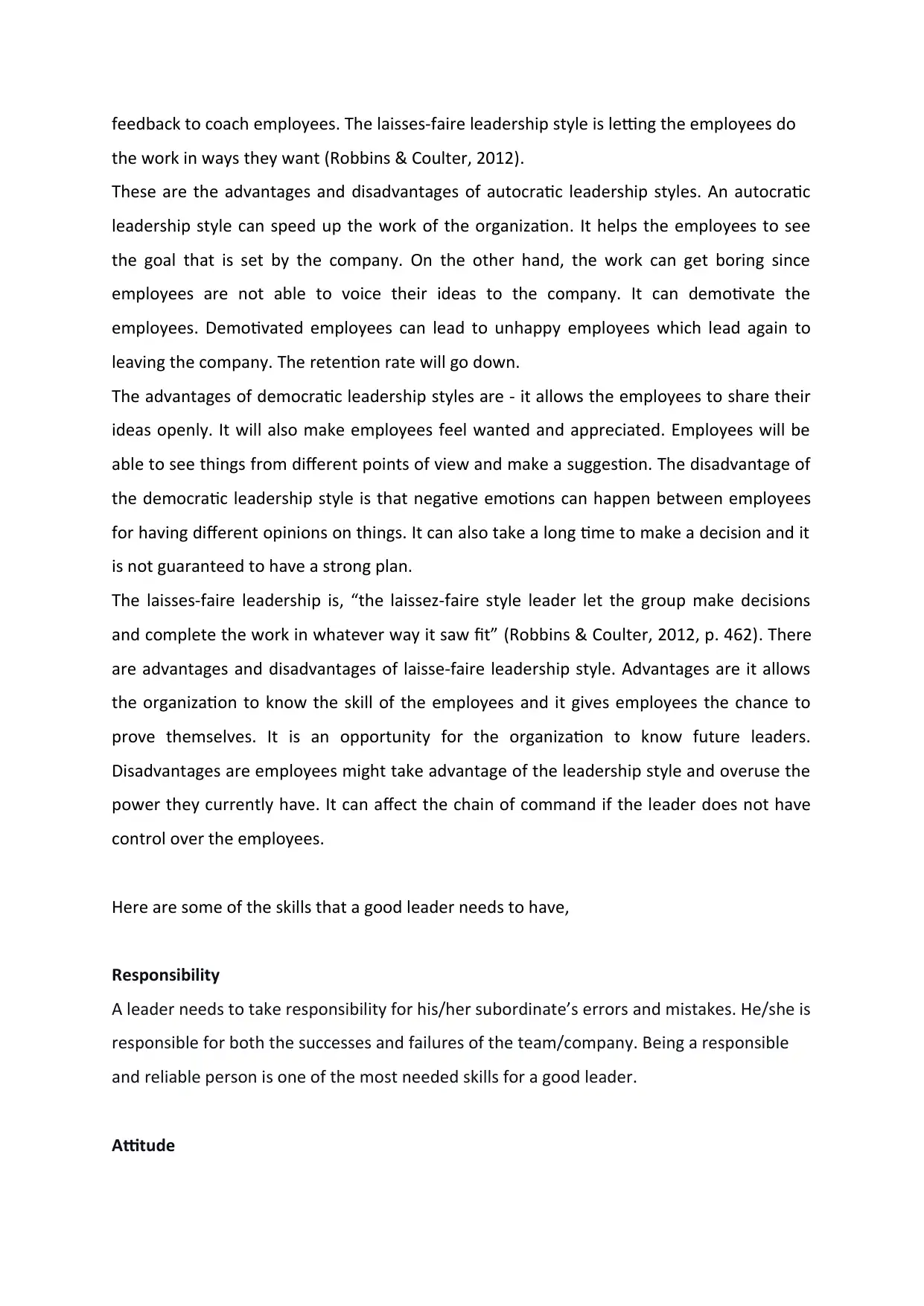
feedback to coach employees. The laisses-faire leadership style is letting the employees do
the work in ways they want (Robbins & Coulter, 2012).
These are the advantages and disadvantages of autocratic leadership styles. An autocratic
leadership style can speed up the work of the organization. It helps the employees to see
the goal that is set by the company. On the other hand, the work can get boring since
employees are not able to voice their ideas to the company. It can demotivate the
employees. Demotivated employees can lead to unhappy employees which lead again to
leaving the company. The retention rate will go down.
The advantages of democratic leadership styles are - it allows the employees to share their
ideas openly. It will also make employees feel wanted and appreciated. Employees will be
able to see things from different points of view and make a suggestion. The disadvantage of
the democratic leadership style is that negative emotions can happen between employees
for having different opinions on things. It can also take a long time to make a decision and it
is not guaranteed to have a strong plan.
The laisses-faire leadership is, “the laissez-faire style leader let the group make decisions
and complete the work in whatever way it saw fit” (Robbins & Coulter, 2012, p. 462). There
are advantages and disadvantages of laisse-faire leadership style. Advantages are it allows
the organization to know the skill of the employees and it gives employees the chance to
prove themselves. It is an opportunity for the organization to know future leaders.
Disadvantages are employees might take advantage of the leadership style and overuse the
power they currently have. It can affect the chain of command if the leader does not have
control over the employees.
Here are some of the skills that a good leader needs to have,
Responsibility
A leader needs to take responsibility for his/her subordinate’s errors and mistakes. He/she is
responsible for both the successes and failures of the team/company. Being a responsible
and reliable person is one of the most needed skills for a good leader.
Attitude
the work in ways they want (Robbins & Coulter, 2012).
These are the advantages and disadvantages of autocratic leadership styles. An autocratic
leadership style can speed up the work of the organization. It helps the employees to see
the goal that is set by the company. On the other hand, the work can get boring since
employees are not able to voice their ideas to the company. It can demotivate the
employees. Demotivated employees can lead to unhappy employees which lead again to
leaving the company. The retention rate will go down.
The advantages of democratic leadership styles are - it allows the employees to share their
ideas openly. It will also make employees feel wanted and appreciated. Employees will be
able to see things from different points of view and make a suggestion. The disadvantage of
the democratic leadership style is that negative emotions can happen between employees
for having different opinions on things. It can also take a long time to make a decision and it
is not guaranteed to have a strong plan.
The laisses-faire leadership is, “the laissez-faire style leader let the group make decisions
and complete the work in whatever way it saw fit” (Robbins & Coulter, 2012, p. 462). There
are advantages and disadvantages of laisse-faire leadership style. Advantages are it allows
the organization to know the skill of the employees and it gives employees the chance to
prove themselves. It is an opportunity for the organization to know future leaders.
Disadvantages are employees might take advantage of the leadership style and overuse the
power they currently have. It can affect the chain of command if the leader does not have
control over the employees.
Here are some of the skills that a good leader needs to have,
Responsibility
A leader needs to take responsibility for his/her subordinate’s errors and mistakes. He/she is
responsible for both the successes and failures of the team/company. Being a responsible
and reliable person is one of the most needed skills for a good leader.
Attitude
⊘ This is a preview!⊘
Do you want full access?
Subscribe today to unlock all pages.

Trusted by 1+ million students worldwide
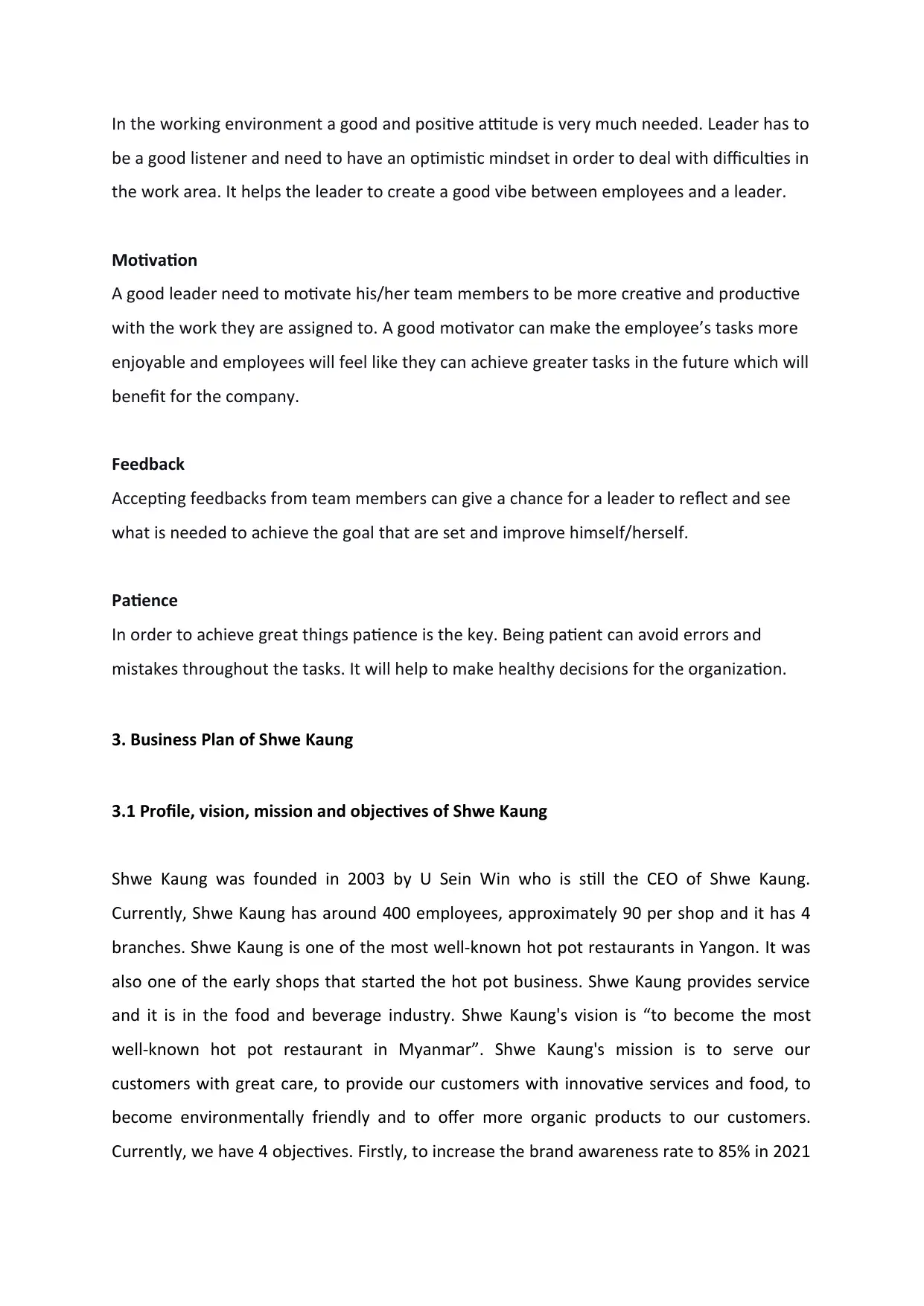
In the working environment a good and positive attitude is very much needed. Leader has to
be a good listener and need to have an optimistic mindset in order to deal with difficulties in
the work area. It helps the leader to create a good vibe between employees and a leader.
Motivation
A good leader need to motivate his/her team members to be more creative and productive
with the work they are assigned to. A good motivator can make the employee’s tasks more
enjoyable and employees will feel like they can achieve greater tasks in the future which will
benefit for the company.
Feedback
Accepting feedbacks from team members can give a chance for a leader to reflect and see
what is needed to achieve the goal that are set and improve himself/herself.
Patience
In order to achieve great things patience is the key. Being patient can avoid errors and
mistakes throughout the tasks. It will help to make healthy decisions for the organization.
3. Business Plan of Shwe Kaung
3.1 Profile, vision, mission and objectives of Shwe Kaung
Shwe Kaung was founded in 2003 by U Sein Win who is still the CEO of Shwe Kaung.
Currently, Shwe Kaung has around 400 employees, approximately 90 per shop and it has 4
branches. Shwe Kaung is one of the most well-known hot pot restaurants in Yangon. It was
also one of the early shops that started the hot pot business. Shwe Kaung provides service
and it is in the food and beverage industry. Shwe Kaung's vision is “to become the most
well-known hot pot restaurant in Myanmar”. Shwe Kaung's mission is to serve our
customers with great care, to provide our customers with innovative services and food, to
become environmentally friendly and to offer more organic products to our customers.
Currently, we have 4 objectives. Firstly, to increase the brand awareness rate to 85% in 2021
be a good listener and need to have an optimistic mindset in order to deal with difficulties in
the work area. It helps the leader to create a good vibe between employees and a leader.
Motivation
A good leader need to motivate his/her team members to be more creative and productive
with the work they are assigned to. A good motivator can make the employee’s tasks more
enjoyable and employees will feel like they can achieve greater tasks in the future which will
benefit for the company.
Feedback
Accepting feedbacks from team members can give a chance for a leader to reflect and see
what is needed to achieve the goal that are set and improve himself/herself.
Patience
In order to achieve great things patience is the key. Being patient can avoid errors and
mistakes throughout the tasks. It will help to make healthy decisions for the organization.
3. Business Plan of Shwe Kaung
3.1 Profile, vision, mission and objectives of Shwe Kaung
Shwe Kaung was founded in 2003 by U Sein Win who is still the CEO of Shwe Kaung.
Currently, Shwe Kaung has around 400 employees, approximately 90 per shop and it has 4
branches. Shwe Kaung is one of the most well-known hot pot restaurants in Yangon. It was
also one of the early shops that started the hot pot business. Shwe Kaung provides service
and it is in the food and beverage industry. Shwe Kaung's vision is “to become the most
well-known hot pot restaurant in Myanmar”. Shwe Kaung's mission is to serve our
customers with great care, to provide our customers with innovative services and food, to
become environmentally friendly and to offer more organic products to our customers.
Currently, we have 4 objectives. Firstly, to increase the brand awareness rate to 85% in 2021
Paraphrase This Document
Need a fresh take? Get an instant paraphrase of this document with our AI Paraphraser
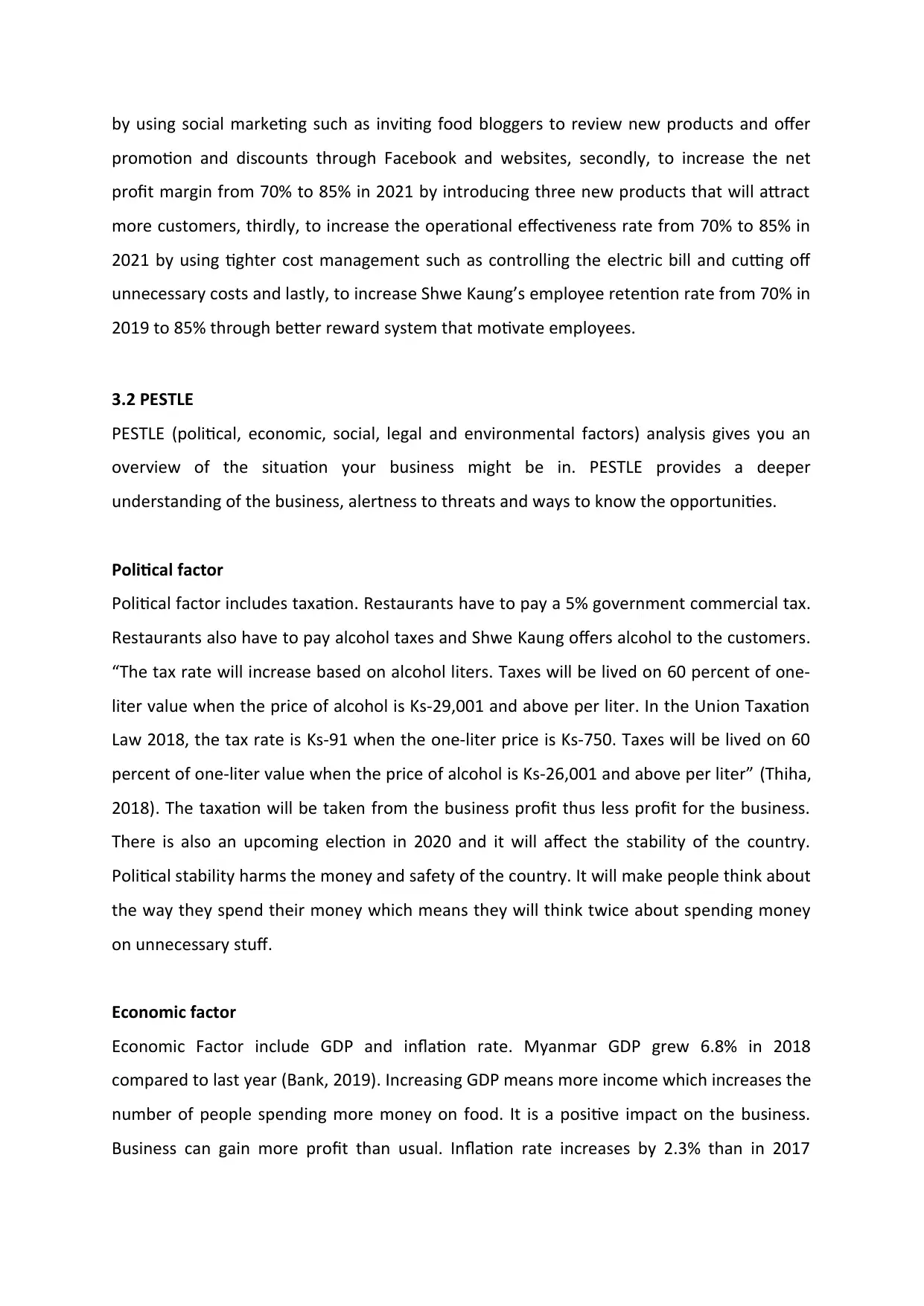
by using social marketing such as inviting food bloggers to review new products and offer
promotion and discounts through Facebook and websites, secondly, to increase the net
profit margin from 70% to 85% in 2021 by introducing three new products that will attract
more customers, thirdly, to increase the operational effectiveness rate from 70% to 85% in
2021 by using tighter cost management such as controlling the electric bill and cutting off
unnecessary costs and lastly, to increase Shwe Kaung’s employee retention rate from 70% in
2019 to 85% through better reward system that motivate employees.
3.2 PESTLE
PESTLE (political, economic, social, legal and environmental factors) analysis gives you an
overview of the situation your business might be in. PESTLE provides a deeper
understanding of the business, alertness to threats and ways to know the opportunities.
Political factor
Political factor includes taxation. Restaurants have to pay a 5% government commercial tax.
Restaurants also have to pay alcohol taxes and Shwe Kaung offers alcohol to the customers.
“The tax rate will increase based on alcohol liters. Taxes will be lived on 60 percent of one-
liter value when the price of alcohol is Ks-29,001 and above per liter. In the Union Taxation
Law 2018, the tax rate is Ks-91 when the one-liter price is Ks-750. Taxes will be lived on 60
percent of one-liter value when the price of alcohol is Ks-26,001 and above per liter” (Thiha,
2018). The taxation will be taken from the business profit thus less profit for the business.
There is also an upcoming election in 2020 and it will affect the stability of the country.
Political stability harms the money and safety of the country. It will make people think about
the way they spend their money which means they will think twice about spending money
on unnecessary stuff.
Economic factor
Economic Factor include GDP and inflation rate. Myanmar GDP grew 6.8% in 2018
compared to last year (Bank, 2019). Increasing GDP means more income which increases the
number of people spending more money on food. It is a positive impact on the business.
Business can gain more profit than usual. Inflation rate increases by 2.3% than in 2017
promotion and discounts through Facebook and websites, secondly, to increase the net
profit margin from 70% to 85% in 2021 by introducing three new products that will attract
more customers, thirdly, to increase the operational effectiveness rate from 70% to 85% in
2021 by using tighter cost management such as controlling the electric bill and cutting off
unnecessary costs and lastly, to increase Shwe Kaung’s employee retention rate from 70% in
2019 to 85% through better reward system that motivate employees.
3.2 PESTLE
PESTLE (political, economic, social, legal and environmental factors) analysis gives you an
overview of the situation your business might be in. PESTLE provides a deeper
understanding of the business, alertness to threats and ways to know the opportunities.
Political factor
Political factor includes taxation. Restaurants have to pay a 5% government commercial tax.
Restaurants also have to pay alcohol taxes and Shwe Kaung offers alcohol to the customers.
“The tax rate will increase based on alcohol liters. Taxes will be lived on 60 percent of one-
liter value when the price of alcohol is Ks-29,001 and above per liter. In the Union Taxation
Law 2018, the tax rate is Ks-91 when the one-liter price is Ks-750. Taxes will be lived on 60
percent of one-liter value when the price of alcohol is Ks-26,001 and above per liter” (Thiha,
2018). The taxation will be taken from the business profit thus less profit for the business.
There is also an upcoming election in 2020 and it will affect the stability of the country.
Political stability harms the money and safety of the country. It will make people think about
the way they spend their money which means they will think twice about spending money
on unnecessary stuff.
Economic factor
Economic Factor include GDP and inflation rate. Myanmar GDP grew 6.8% in 2018
compared to last year (Bank, 2019). Increasing GDP means more income which increases the
number of people spending more money on food. It is a positive impact on the business.
Business can gain more profit than usual. Inflation rate increases by 2.3% than in 2017
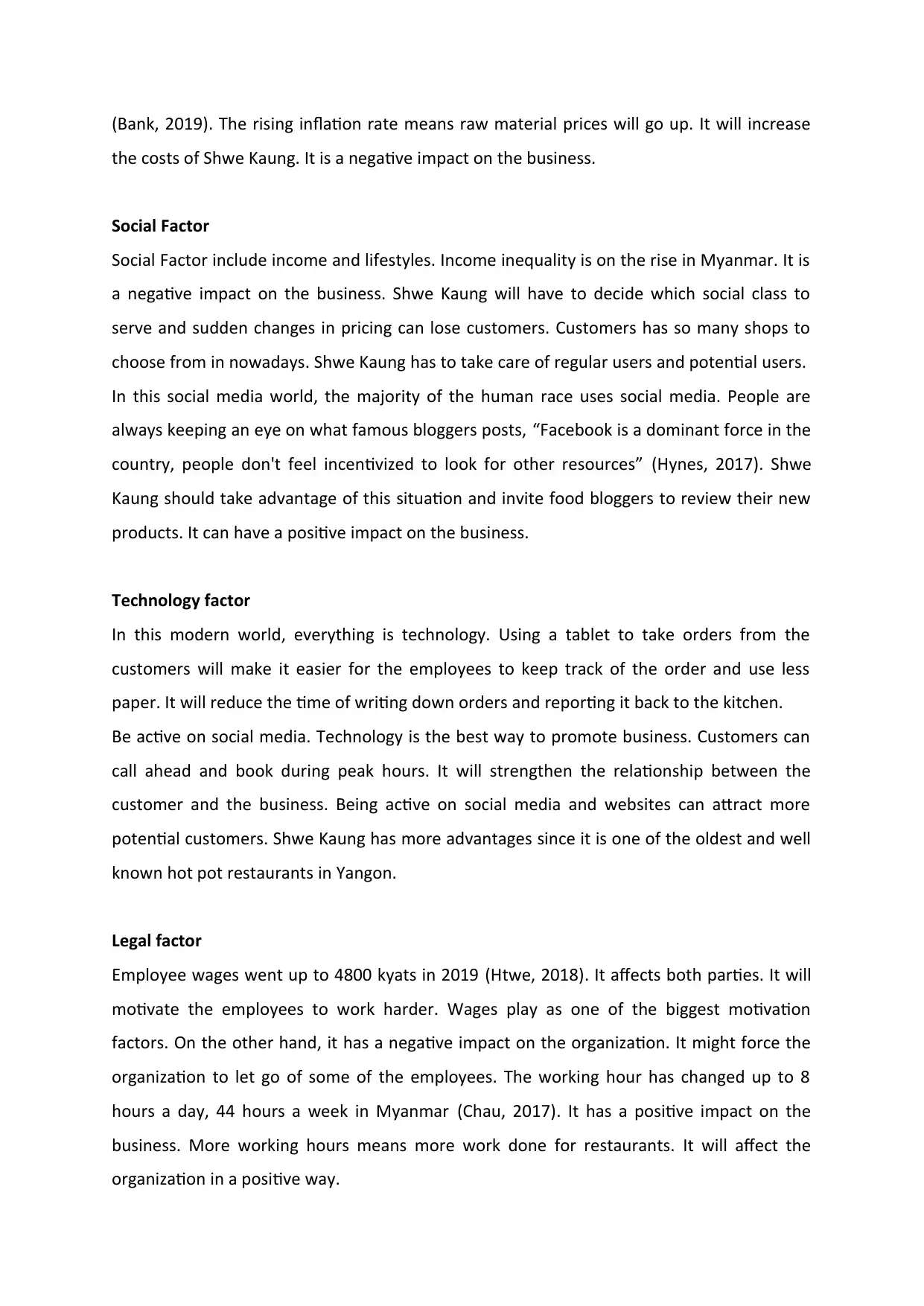
(Bank, 2019). The rising inflation rate means raw material prices will go up. It will increase
the costs of Shwe Kaung. It is a negative impact on the business.
Social Factor
Social Factor include income and lifestyles. Income inequality is on the rise in Myanmar. It is
a negative impact on the business. Shwe Kaung will have to decide which social class to
serve and sudden changes in pricing can lose customers. Customers has so many shops to
choose from in nowadays. Shwe Kaung has to take care of regular users and potential users.
In this social media world, the majority of the human race uses social media. People are
always keeping an eye on what famous bloggers posts, “Facebook is a dominant force in the
country, people don't feel incentivized to look for other resources” (Hynes, 2017). Shwe
Kaung should take advantage of this situation and invite food bloggers to review their new
products. It can have a positive impact on the business.
Technology factor
In this modern world, everything is technology. Using a tablet to take orders from the
customers will make it easier for the employees to keep track of the order and use less
paper. It will reduce the time of writing down orders and reporting it back to the kitchen.
Be active on social media. Technology is the best way to promote business. Customers can
call ahead and book during peak hours. It will strengthen the relationship between the
customer and the business. Being active on social media and websites can attract more
potential customers. Shwe Kaung has more advantages since it is one of the oldest and well
known hot pot restaurants in Yangon.
Legal factor
Employee wages went up to 4800 kyats in 2019 (Htwe, 2018). It affects both parties. It will
motivate the employees to work harder. Wages play as one of the biggest motivation
factors. On the other hand, it has a negative impact on the organization. It might force the
organization to let go of some of the employees. The working hour has changed up to 8
hours a day, 44 hours a week in Myanmar (Chau, 2017). It has a positive impact on the
business. More working hours means more work done for restaurants. It will affect the
organization in a positive way.
the costs of Shwe Kaung. It is a negative impact on the business.
Social Factor
Social Factor include income and lifestyles. Income inequality is on the rise in Myanmar. It is
a negative impact on the business. Shwe Kaung will have to decide which social class to
serve and sudden changes in pricing can lose customers. Customers has so many shops to
choose from in nowadays. Shwe Kaung has to take care of regular users and potential users.
In this social media world, the majority of the human race uses social media. People are
always keeping an eye on what famous bloggers posts, “Facebook is a dominant force in the
country, people don't feel incentivized to look for other resources” (Hynes, 2017). Shwe
Kaung should take advantage of this situation and invite food bloggers to review their new
products. It can have a positive impact on the business.
Technology factor
In this modern world, everything is technology. Using a tablet to take orders from the
customers will make it easier for the employees to keep track of the order and use less
paper. It will reduce the time of writing down orders and reporting it back to the kitchen.
Be active on social media. Technology is the best way to promote business. Customers can
call ahead and book during peak hours. It will strengthen the relationship between the
customer and the business. Being active on social media and websites can attract more
potential customers. Shwe Kaung has more advantages since it is one of the oldest and well
known hot pot restaurants in Yangon.
Legal factor
Employee wages went up to 4800 kyats in 2019 (Htwe, 2018). It affects both parties. It will
motivate the employees to work harder. Wages play as one of the biggest motivation
factors. On the other hand, it has a negative impact on the organization. It might force the
organization to let go of some of the employees. The working hour has changed up to 8
hours a day, 44 hours a week in Myanmar (Chau, 2017). It has a positive impact on the
business. More working hours means more work done for restaurants. It will affect the
organization in a positive way.
⊘ This is a preview!⊘
Do you want full access?
Subscribe today to unlock all pages.

Trusted by 1+ million students worldwide
1 out of 22
Related Documents
Your All-in-One AI-Powered Toolkit for Academic Success.
+13062052269
info@desklib.com
Available 24*7 on WhatsApp / Email
![[object Object]](/_next/static/media/star-bottom.7253800d.svg)
Unlock your academic potential
Copyright © 2020–2025 A2Z Services. All Rights Reserved. Developed and managed by ZUCOL.





